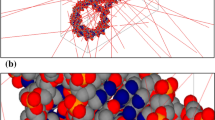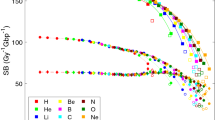Abstract
The Monte Carlo track structure code PARTRAC has been further improved by implementing electron scattering cross-sections for liquid water and by explicitly modelling the interaction of water radicals with DNA. The model of the genome inside a human cell nucleus in its interphase is based on the atomic coordinates of the DNA double helix with an additional volume for the water shell. The DNA helix is wound around histone complexes, and these nucleosomes are folded into chromatin fibres and further to fibre loops, which are interconnected to build chromosomes with a territorial organisation. Simulations have been performed for the irradiation of human fibroblast cells with carbon K and aluminium K ultrasoft x-rays, 220 kVp x-rays and 60Co γ-rays. The ratio single-strand breaks to double-strand breaks (ssb/dsb) for both types of ultrasoft x-rays is lower than for γ-rays by a factor of 2. The contributions of direct and indirect effects to strand break induction are almost independent of photon energy. Strand break patterns from indirect effects reflect differences in the susceptibility of the DNA helix to OH• attack inside the chromatin fibre. Distributions of small DNA fragments (<3 kbp) are determined by the chromatin fibre structure irrespective of whether direct or indirect effects are causing the breaks. In the calculated fragment size distributions for larger DNA fragments (>30 kbp), a substantial deviation from random breakage is found only for carbon K irradiation, and is attributed to its inhomogeneous dose distribution inside the cell nucleus. For the other radiation qualities, the results for larger fragments can be approximated by random breakage distributions calculated for a yield of dsb which is about 10% lower than the average for the whole genome. The excess of DNA fragments detected experimentally in the 8–300 kbp region after x-ray irradiation is not seen in our simulation results.
Similar content being viewed by others
Author information
Authors and Affiliations
Additional information
Received: 19 October 1998 / Accepted in revised form: 14 January 1999
Rights and permissions
About this article
Cite this article
Friedland, W., Jacob, P., Paretzke, H. et al. Simulation of DNA fragment distributions after irradiation with photons. Radiat Environ Biophys 38, 39–47 (1999). https://doi.org/10.1007/s004110050136
Issue Date:
DOI: https://doi.org/10.1007/s004110050136




